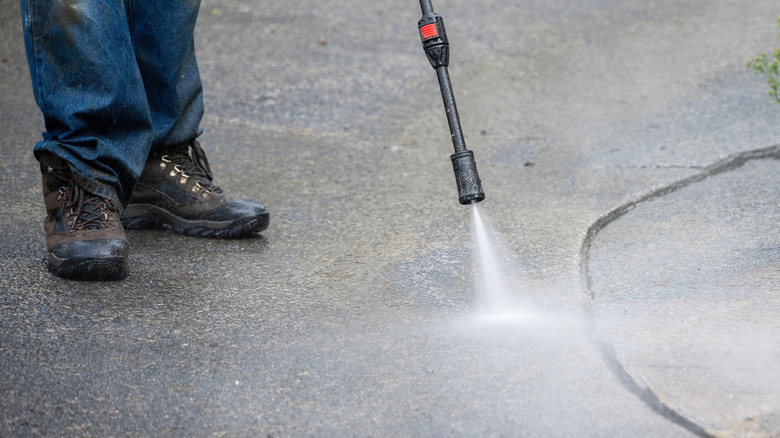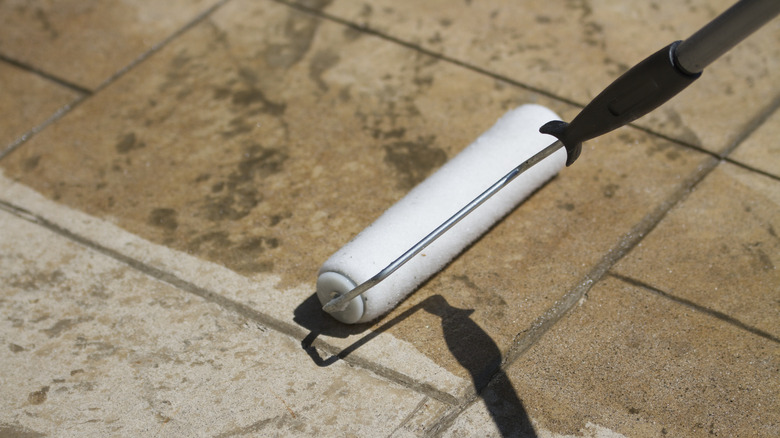How To Stain Concrete To Give Your Walkways A Fresh Look
We may receive a commission on purchases made from links.
Known for being one of the strongest building materials, concrete is used in construction projects to form everything from buildings to walkways. However, even with its impressive ability to withstand the elements, concrete can become discolored over time from varying factors, like not cleaning the surface regularly. Instead of having to dish out the costs associated with professional restoration services, you can learn how to stain the concrete to breathe new life into it. Though it can be tedious and time-consuming, this is a project even beginners can tackle with a little patience and the right tools. For this outdoor project, all you have to do is clean the concrete, repair any surface cracks, and spray on a water- or acid-based stain to refresh your walkway.
Before learning how to stain concrete, it's important to understand the different types of products available to determine which is best for your walkway. Stains come in many different color options and finishes, but there are two main types that home DIYers should know about. These are acid-based and water-based stains. Both will change the appearance of concrete but differ in how they work. Water-based stains essentially dye the top layer of the concrete, while acid stains cause a chemical reaction that creates a very unique design that often mimics the look of natural stone. It is important to note that acid-based products can be a bit more difficult to work with, so novice DIYers should keep this in mind.
How to prepare a concrete walkway for staining
The first step of this process doesn't involve staining at all. Instead, this weekend DIY renovation project must begin with thorough surface preparation. Start by grabbing a broom to sweep away any dirt or debris. For concrete with heavy buildup, you may have to use a pressure washer. This is also a good time to inspect the walkway for any visible cracks, specifically those wide enough to fit a coin into. Thin, hairline cracks are less of a concern structurally but can be filled for aesthetics. Repair any cracks with a caulk gun and a product like DAPConcrete Watertight Filler and Sealent and allow it to dry fully or for at least 24 hours.
Once the surface is clean, it's time to buff the concrete to make sure it's porous enough to absorb the color of the stain. This will also help to smooth out any repaired areas. Walkways being prepared for water-based stain can be prepped with a standard scrubber, but concrete destined for an acid stain will need a different approach. This scenario requires etching, which you can achieve by using an acidic chemical solution or physically grinding it down with machinery. One clever trick to tell if your concrete is ready for staining is to drop a small amount of water onto the surface and wait for 60 seconds. If it absorbs, the material is ready. If it sits on the top, you'll need to buff it more.
Steps to stain a concrete walkway
It's important to note that the application process can vary between acid and water-based stains. To start, know that acid stains work well with sprayers, but you must use an acid-resistant model. A sprayer will allow you to apply an even coat. Smaller areas can be covered with a brush or small spray bottle. Let the acid process according to the manufacturer instructions before deciding if you will need to add additional layers. Once satisfied with the color, you must neutralize the stain and remove any residue. Use a commercial product or mixture of 4 cups of baking soda and 1 gallon of water on the concrete and gently scrub with a soft brush. Rinse until all residue is gone.
Water-based stains are a bit easier to work with and can be applied with a roller, brush, or sprayer. When applying this type of stain, it can be helpful to overlay your brush or roller strokes as you go to keep a smooth edge. You may also find better results by starting with a thin coat and building layers until you reach the desired color.
Regardless of the type of stain, be sure to let it dry completely before sealing the concrete. While this is a relatively simple project, there are some common mistakes to avoid while staining concrete. For example, consider testing out the stain in an inconspicuous area of the concrete before diving right in to make sure the final look is something you'll enjoy long-term.


